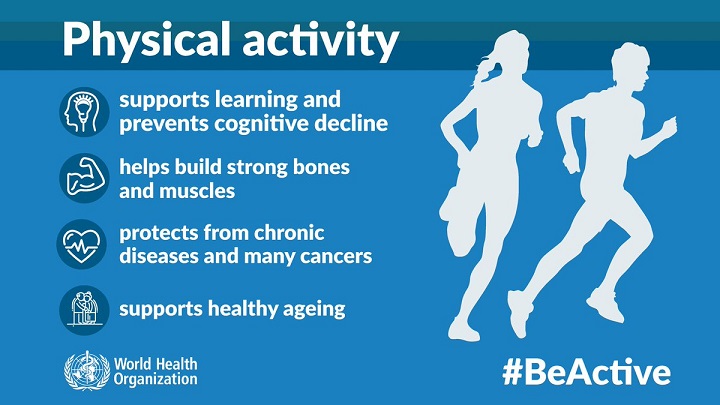Physical activity has significant health benefits for hearts, bodies and minds

Regular physical activity, such as walking, cycling, wheeling, doing sports or active recreation, provides significant benefits for health. Some physical activity is better than doing none. By becoming more active throughout the day in relatively simple ways, people can easily achieve the recommended activity levels.
Physical inactivity is one of the leading risk factors for noncommunicable diseases mortality. People who are insufficiently active have a 20% to 30% increased risk of death compared to people who are sufficiently active.
What is physical activity?
WHO defines physical activity as any bodily movement produced by skeletal muscles that requires energy expenditure. Physical activity refers to all movement including during leisure time, for transport to get to and from places, or as part of a person’s work. Both moderate- and vigorous-intensity physical activity improve health.
Popular ways to be active include walking, cycling, wheeling, sports, active recreation and play, and can be done at any level of skill and for enjoyment by everybody.
Regular physical activity is proven to help prevent and manage noncommunicable diseases such as heart disease, stroke, diabetes and several cancers. It also helps prevent hypertension, maintain healthy body weight and can improve mental health, quality of life and well-being.

Regular physical activity can:
- improve muscular and cardiorespiratory fitness;
- improve bone and functional health;
- reduce the risk of hypertension, coronary heart disease, stroke, diabetes, various types of cancer (including breast cancer and colon cancer), and depression;
- reduce the risk of falls as well as hip or vertebral fractures; and
- help maintain a healthy body weight.
In children and adolescents, physical activity improves:
- physical fitness (cardiorespiratory and muscular fitness)
- cardiometabolic health (blood pressure, dyslipidaemia, glucose, and insulin resistance)
- bone health
- cognitive outcomes (academic performance, executive function)
- mental health (reduced symptoms of depression)
- reduced adiposity
In adults and older adults, higher levels of physical activity improves:
- risk of all-cause mortality
- risk of cardiovascular disease mortality
- incident hypertension
- incident site-specific cancers (bladder, breast, colon, endometrial, oesophageal adenocarcinoma, gastric and renal cancers)
- incident type-2 diabetes
- prevents of falls
- mental health (reduced symptoms of anxiety and depression)
- cognitive health
- sleep
- measures of adiposity may also improve
For pregnant and post-partum women
Physical activity confers the following maternal and fetal health benefits: a decreased risk of:
- pre-eclampsia,
- gestational hypertension,
- gestational diabetes (for example 30% reduction in risk)
- excessive gestational weight gain,
- delivery complications
- postpartum depression
- newborn complications,
- and physical activity has no adverse effects on birthweight or increased risk of stillbirth.
Health risks of sedentary behaviour
Lives are becoming increasingly sedentary, through the use of motorized transport and the increased use of screens for work, education and recreation. Evidence shows higher amounts of sedentary behaviour are associated with the following poor health outcomes:
In children and adolescents:
- increased adiposity (weight gain)
- poorer cardiometabolic health, fitness, behavioural conduct/pro-social behaviour
- reduced sleep duration
In adults:
- all-cause mortality, cardiovascular disease mortality and cancer mortality
- incidence of cardiovascular disease, cancer and type-2 diabetes.
Levels of physical activity globally
- More than a quarter of the world’s adult population (1.4 billion adults) are insufficiently active
- Worldwide, around 1 in 3 women and 1 in 4 men do not do enough physical activity to stay healthy.
- Levels of inactivity are twice as high in high-income countries compared to low-income countries,
- There has been no improvement in global levels of physical activity since 2001
- Insufficient activity increased by 5% (from 31.6% to 36.8%) in high-income countries between 2001 and 2016.
Increased levels of physical inactivity have negative impacts on health systems, the environment, economic development, community well-being and quality of life.
Globally, 28% of adults aged 18 and over were not active enough in 2016 (men 23% and women 32%). This means they do not meet the global recommendations of at least 150 minutes of moderate-intensity, or 75 minutes vigorous-intensity physical activity per week.
In high-income countries, 26% of men and 35% of women were insufficiently physically active, as compared to 12% of men and 24% of women in low-income countries. Low or decreasing physical activity levels often correspond with a high or rising gross national product.
The drop in physical activity is partly due to inaction during leisure time and sedentary behaviour on the job and at home. Likewise, an increase in the use of “passive” modes of transportation also contributes to insufficient physical activity.
Globally, 81% of adolescents aged 11-17 years were insufficiently physically active in 2016. Adolescent girls were less active than adolescent boys, with 85% vs. 78% not meeting WHO recommendations of at least 60 minutes of moderate to vigorous intensity physical activity per day.
How to increase physical activity?
Countries and communities must take action to provide everyone with more opportunities to be active, in order to increase physical activity. This requires a collective effort, both national and local, across different sectors and disciplines to implement policy and solutions appropriate to a country’s cultural and social environment to promote, enable and encourage physical activity.
Policies to increase physical activity aim to ensure that:
- walking, cycling and other forms of active non-motorized forms of transport are accessible and safe for all;
- labour and workplace policies encourage active commuting and opportunities for being physically active during the work day;
- childcare, schools and higher education institutions provide supportive and safe spaces and facilities for all students to spend their free time actively;
- primary and secondary schools provide quality physical education that supports children to develop behaviour patterns that will keep them physically active throughout their lives;
- community-based and school-sport programmes provide appropriate opportunities for all ages and abilities;
- sports and recreation facilities provide opportunities for everyone to access and participate in a variety of different sports, dance, exercise and active recreation; and
- health care providers advise and support patients to be regularly active. COURTESY WHO
